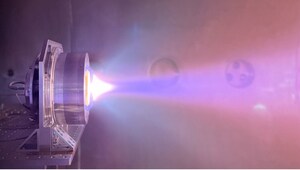Electric Propulsion Pioneer Phase Four Reveals Results That Challenge Incumbents on Performance, Promising a New Era of Satellite Functionality
Tests reveal 6x improvement in power and performance, results on par with Hall thrusters
COLORADO SPRINGS, Colo., April 16, 2018 /PRNewswire/ -- Space Symposium -- Phase Four, a provider of electric radio frequency (RF) thrusters for in-space propulsion, today announced the results of third party performance testing by The Aerospace Corporation, a provider of independent technical and scientific research to national security space (NSS) programs. The testing found Phase Four's second generation of RF thrusters achieved their best performance to date, demonstrating performance on par with today's state-of-the-art Hall Effect Thrusters (HETs) and a 3000% efficiency increase over all existing RF plasma thrusters. Phase Four's Chief Scientist, Dr. M. Umair Siddiqui will reveal the full set of findings in his "Technology Testing" panel today at the 34th Space Symposium in Colorado Springs, Colorado.
The Phase Four CubeSat Class RF thruster tested by The Aerospace Corporation achieved the highest performing electrode-free RF engine data ever directly measured, producing up to 3.3 mN of thrust at 700 seconds specific impulse. The improvements were 6x greater than the proof-of-concept "RFT-0" and were a 30x improvement in specific impulse per Watt over any RF thruster ever directly tested on a thrust stand. Phase Four's RF thruster achieved this despite being less than 10% mass and volume of other systems. This is significant as the RF thruster is particularly easy to manufacture compared to incumbents, making it a strong candidate for a mass-produced engine for satellite mega-constellations.
"These results validate our vision: to increase access to space by producing a thruster that can be used by all satellites, while matching performance levels previously available only to huge and expensive spacecraft," said Dr. M. Umair Siddiqui, Chief Scientist of Phase Four. "This sets a new bar for what can be achieved with these smaller electric thrusters, which offer high levels of power while eliminating many of the design and manufacturability issues - electrodes, complex electronics, and complex fabrication - which have plagued electric propulsion systems to date."
"From the outset, our goal has been to match the incredible innovation happening within the small satellite sector by tackling the two largest challenges to its growth: cost and performance," said Simon Halpern, Founder and CEO of Phase Four. "In this testing, our thrusters achieved a first for the industry – performance rates that exceed those of existing state-of-the-art Gridded Ion Engines and Hall Effect Thrusters. Rather than attempting to working around 50-year-old thruster technology, we started from scratch, with the goal of providing more efficiency, maneuverability and inherent manufacturability. The results we achieve today will point to a promising new range of capabilities for the entire satellite industry."
About Phase Four
Based in El Segundo, California, Phase Four is enabling the exponential growth of satellite constellations by solving the satellite's costliest problem, the propulsion system. The company's electrode-less RF thruster is the smallest plasma propulsion system available today, and can be scaled for use from CubeSats to small sats to school bus-sized satellites. By eliminating the most common failure points in incumbent technologies - electrodes, high-voltage electronics, and complex fabrication - Phase Four has built a system that is reliable and offers high-performance with baked-in manufacturability. Designed with tomorrow's satellites and constellations in mind, the P4 RF thruster brings small sats the same performance levels of large satellites, in a simpler form factor. Phase Four is proof that high performance can come in small packages. Visit us at: www.phasefour.io
SOURCE Phase Four
Related Links
WANT YOUR COMPANY'S NEWS FEATURED ON PRNEWSWIRE.COM?
Newsrooms &
Influencers
Digital Media
Outlets
Journalists
Opted In






Share this article